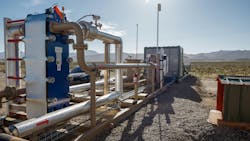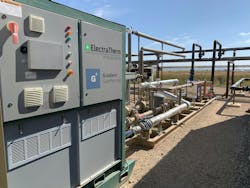Oil and Gas Geothermal Promise: Harnessing Subterranean CHP to Power Industry
Sometimes the problem is the solution.
Whether it’s medicine, digital technology or energy, deep threats often have been turned into synergistic allies throughout understanding and then inverting the bad into something good. Consider the polio vaccine, in which the virus itself was also the pathway to protection that has saved millions of lives.
Another example is the scaling up of artificial intelligence, which does possess an overt challenge to grid power resource adequacy and cybersecurity. Yet AI can be used in ways to clearly help the energy industry operate and communicate infinitely more efficiently.
Perhaps the same inverse power using big challenges to solve big programs is formed deep underneath the ground. Geothermal forces emanating from the earth’s core can cause all kinds of cataclysms such as volcanoes, earthquakes or dangerous gas eruptions, sometimes propelling runaway oil blowouts now infamous in drilling history.
And yet geothermal contains within its hypercharged circulatory system the very answers to help achieve scale in decarbonized energy. These geothermic answers include steam and air delivery systems from deep wells and even at legacy oil and gas drilling sites.
Gradient capitalizing on heat from oil and gas ops
One relatively new company working to harness the subterranean heat by unique means is Gradient Geothermal. The Denver-based firm creates combined heat and power (CHP) from produced water pulled from drilling operations.
Gradient Geothermal CEO Benjamin Burke, chatting with EnergyTech.com recently, said this type of geothermal has a potential energy capacity comparable to rooftop solar and ultimately might deliver a 13-GW power generation opportunity.
“Of the about 2.9 million wells currently and ever drilled, we estimate there are 500,000 wells which have enough flow (of produced water) and enough temperature to be relevant for this,” Burke noted. “These would be anything with more than 160 degrees Fahrenheit and flows hundreds of barrels per day.”
Oil and gas reservoirs contain untold volumes of deep ground water which also are pushed up with production operations. The water radiates with the heat emanating from the earth’s molten core and offers power potential within that heat.
“Temperature is the critical item,” Burke added.
Gradient Geothermal’s work has been tested through its initial pilot project at a U.S. Department of Energy-supported site in Blackburn, Nevada, two years ago. Since then, the company is starting to commercialize its on-site CHP technology through a partnership with oil and gas exploration and production firm Chord Energy on a project in North Dakota.
In essence, Gradient turns drilling-produced water into CHP and cooling technology this way: The produced water is pumped to the surface, running through a heat exchange system loop with water and antifreeze, utilizing the organic Rankine cycle (ORC).
The ORC allows for heat recovery from fluid with vaporization temperature below that of water (which has a boiling temperature of 212 degrees Fahrenheit). The Gradient on-site system allows engages a refrigerant in a liquid phase to interact with the heat, thus converting from liquid to vapor to expand and then drive a compressor screw.
Throughout the cycle, it turns hot water into cooler water and vapor to drive power generation and provide both heat and cooling. The produced water eventually is transferred into deep underground injection wells, as it would have been all along anyway with drilling operations.
“There’s no emissions and minimal sound,” Burke said.
The mega potential of micro CHP geothermal power
Gradient Geothermal was formed five years ago out of the merger of Transitional Energy LLC and X Machina Sustainable Technologies. Burke holds a doctorate in Earth Sciences from Dartmouth and previously served as president of the Rocky Mountain Association of Geologists and also as chief technical officer at Transitional Energy.
What intrigues him about the potential of geothermal within legacy oil and gas drilling sites is like delivering a micro power version of the macro potential in global geothermal. A report on geothermal electricity and CHP potential from the European Geothermal Energy Council notes that the overarching heat power of the earth’s crust is close to 12 octillion megajoules or something like massive amounts of Terawatt hours.
Of course, only a fraction of that is feasibly available to utilize for human consumption. Gradient Geothermal’s technology seeks to tap a portion of energy in already produced fluids which can drive power generators and interconnect both to a direct customer or into the utility grid.
“It brings the potential for that power generation into any sedimentary basin, anywhere there is existing wells,” Burke told EnergyTech. “We could do it about anywhere, although we might have to drill deeper in Maine. If you drill deep enough, there will always be hot water.”
And boiling water or fluid is key to power generation from steam turbines to district energy and CHP on college campuses. The underground heat density of geothermal provides a decarbonizing counterpoint to fossil fuel generation, if it can be rendered economically feasible over the long run.
Gradient Geothermal is one of those companies trying, although they are taking the path less traveled by focusing on oil and gas drilling’s produced water. However, the playing field might be rich considering thousands of wells drilled but no longer operating due to relative lack of oil and gas production compared with shale plays and new, directional wells.
Those old oil and gas wells still have some play in them, except for commercial volumes of oil and gas, and perhaps can offer something cleaner in terms of emissions and impact.
So go back to the beginning about problems sometimes supplying their own solutions: Data center energy and cooling demand are threatening to overwhelm both electricity and water supply, but Burke believes that ORC and geothermal technology can work there, too.
“Large data centers also use millions of gallons of water a year to cool,” he pointed out. “This further puts a strain on community resources.
The CHP technology “can recycle this hot water from the cooling of the center to generate electricity,” Burke added. “This can be done over and over again cyclically.”
Utilizing principles of CHP and geothermal to decarbonize two massive energy emitters: Oil and gas and data center. Geothermal does cover a lot of ground, or underground, that is.
About the Author
Rod Walton, EnergyTech Managing Editor
Managing Editor
For EnergyTech editorial inquiries, please contact Managing Editor Rod Walton at [email protected].
Rod Walton has spent 17 years covering the energy industry as a newspaper and trade journalist. He formerly was energy writer and business editor at the Tulsa World. Later, he spent six years covering the electricity power sector for Pennwell and Clarion Events. He joined Endeavor and EnergyTech in November 2021.
Walton earned his Bachelors degree in journalism from the University of Oklahoma. His career stops include the Moore American, Bartlesville Examiner-Enterprise, Wagoner Tribune and Tulsa World.
EnergyTech is focused on the mission critical and large-scale energy users and their sustainability and resiliency goals. These include the commercial and industrial sectors, as well as the military, universities, data centers and microgrids. The C&I sectors together account for close to 30 percent of greenhouse gas emissions in the U.S.
He was named Managing Editor for Microgrid Knowledge and EnergyTech starting July 1, 2023
Many large-scale energy users such as Fortune 500 companies, and mission-critical users such as military bases, universities, healthcare facilities, public safety and data centers, shifting their energy priorities to reach net-zero carbon goals within the coming decades. These include plans for renewable energy power purchase agreements, but also on-site resiliency projects such as microgrids, combined heat and power, rooftop solar, energy storage, digitalization and building efficiency upgrades.



